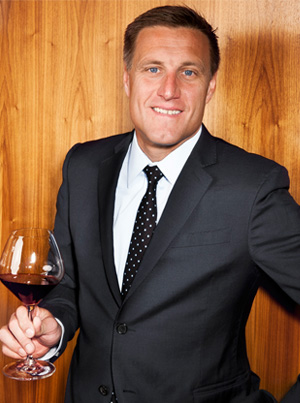Bobby Stuckey opened Frasca Food and Wine ten years ago, around the time that he earned his Master Sommelier diploma, after a career spent in dining rooms like The Little Nell in Aspen and Yountville’s The French Laundry. Luke Sykora checked in with him about what guest are drinking at Frasca ten years in.


Frasca is based around the food and wine of Friuli, a region that’s perhaps not as well-know as some others in Italy. Has there been a learning curve for your guests? Are you now you able to turn people onto wines that probably wouldn’t have flown earlier on?
We have an employee who works for us, Carlin Carr, who came from San Francisco. One thing she said was: “You know what’s crazy, Bobby, you can feel the Frasca effect in Boulder. I went up to a bunch of wine shops in San Francisco to get things that are on your list and you couldn’t.” But if you go to a retail shop in Boulder you can drink things like Ronco delle Betulle, things that you can’t drink outside of New York or Italy.
It’s a lot easier to write our wine list now, and that credit goes to Carlin’s boss Matt Mather. It was hard to write the wine list ten years ago; there just wasn’t the material in the state of Colorado. I had a lot of ins with importers, but no one was really committed to getting us what we needed.
Matt Mather gets all the credit for this: we’re in Friuli a lot as a company. He would find out what he wanted and go to different distributors and say: “I talked to Petrussa and we got it all set up. Look, if we take ten cases of Petrussa Friulano, and we have a retailer that can take five, and if you can sell another five cases on your own, can you bring in 20 cases? All you have to do is bring it, you can drop it off on our front door the day it lands, there’s no risk.” And maybe after two years of doing that you have your feet under yourself, and you’re really carrying the brand. He’s doing that with so many producers. It’s way easier for everyone in Colorado now to get things they really couldn’t get.
A Friulian chardonnay was your top-selling white wine, from Borgo del Tiglio in Collio. Was that more because it’s a familiar entry point to translate people into Friuli, a sort of gateway wine?
We didn’t used to be able to have great Friulano chardonnay on the list. It works in the pairings and all of the sudden it just goes like wildfire.
And we have to watch our balance. At the end of the day, as our guests become so much more educated about Friuli…. Okay, I have this document that I send out to guests when they’re going to Friuli. For a neighborhood restaurant, in a given year, we have over twenty guests going over to Friuli now. And what happens is, those people are so gung-ho. But you still have people coming in who have never been into our restaurant. You can’t just cold call them on something totally obscure. Or maybe you can, if at least one of the selections is a chardonnay.
It’s crazy to see a malvasia among your top wines, from Doro Princic. Can you tell me about that wine? How do you convince people to take a chance on it? That’s a bit of a cold call, I imagine.
First of all, we had to get [the importer] Winebow to take a chance. They imported that producer for 30 years and this is the first time they brought that wine in. We had to commit for a lot of wine. We’ve been asking them since we opened to bring that wine in. It’s not that expensive, and it’s so applicable to our cuisine. Malvasia is all throughout the Adriatic, the Phoenicians took it everywhere, and it pretty much sucks everywhere except that area in Croatia through Friuli where they have the Malvasia Istriana selection. It’s the best seafood wine ever—it’s got all these aromatics and it’s got acidity. It’s like what Condrieu wishes it was, without all the weight and alcohol—you can drink a lot more of it. It’s $60 on the list but it’s something you never had before that works so well with the cuisine. It’s a no-brainer.
The Vajra 2009 Barolo Albe was your best-selling at the end of last year—why did that do so well?
Being a Friulano-based restaurant, red wine’s not the strength there, so we’ve always had a really strong Piemontese culture at Frasca. And that wine is such an overachiever for the price. Barolos have gotten more expensive over the last few years, so to have a wine that over-delivers, for under $100… It’s open-knit but brainy Barolo.
You also sell a fair amount of Tuscan wines—Isole e Olena Chianti Classico, a Montevertine, a cabernet from Bolgheri (a more modern take on Tuscany)—have you always represented those wines somewhat strongly, or are they having a bit of a comeback?
If you spend time in wine bars in Florence and talk to young somms, you’ll hear Tuscany is where Piemonte was five years ago. You had all these producers trying to make all these international wines, but now you have all these producers in Radda inspired by Montevertine working with autochthonous varieties there. And let’s be honest: how many guest come into Frasca after a honeymoon in Tuscany? It’s connected to them in their DNA forever.
A 2001 Etna Rosso from Calabretta, you say, is you biggest recent success. Is that more because it’s Etna, or because it’s a great deal on an aged wine?
The latter. We don’t have a culture of a lot of old or midterm wine in America, but we all know, even if it’s just an inexpensive Napa cab you forgot about in the cellar for a few years…it’s just nice to be able to drink something with a little bit of midterm age on it. But they’re not just ordering it by themselves; I think everything on our list needs a little pointing out. There’s a huge somm-to-guest ratio. Its me and a somm on the floor every night, sometimes three of us, for a 22-table restaurant. I bet you there are not four tables a night that really do the wine list on their own.
And guests love that wine. It’s something they haven’t heard of before. But they know Etna is becoming a more popular region, and here’s one with age on it. It connects a lot of dots for people.
A lot of somms we talk to mention you as a mentor—you’ve spent a lot of time with younger somms making their way through the Court since getting your MS in 2004. As you dine around the US, what do feel like the imprint of the Court is on the current dining landscape?
Not to toot the Court’s horn, but… We have such a resurgence of young wine professionals, which is super-positive. But if there isn’t a context—forcing yourself to taste things you wouldn’t otherwise taste, learning your flaws, etc.—you can really have an off experience even if people are well-meaning. The Court, it forces you to mature a bit as a wine taster, to taste things that you wouldn’t taste unless you were forced to. But [young sommeliers who] aren’t Court-focused, maybe they more get caught up drinking a particular movement. But it’s like: am I really just romancing a flaw here? Or: I’m really into this movement, but maybe that’s not what I need on the list at the moment. It’s amazing how many young professionals without much experience are in positions of influence, and I’m not necessarily against that. But I think those in the Court are succeeding for the guest better.
Longtime senior editor at Wine & Spirits magazine, Luke now works for the Stanford Technology Ventures Program.
















